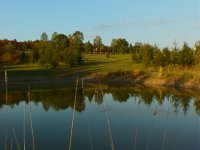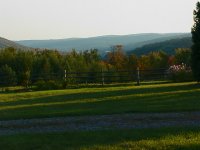Ed--
Ridding a pond of algal bloom is a complex process. If the pond is old enough to have a serious layer of muck resulting from leaves, sticks, dead fish/turtles, etc., then the problem is exacerbated substantially because of the hyperoxygenation resulting from decay. A true solution in such a case might involve actually dredging the bottom, and aeration, etc. probably won't turn the corner. Even with a pond that does not have a lot of muck, I think that unless your son gets both aggressive and lucky, he won't get rid of the current large bloom, which sounds like it probably covers about 1/4-1/2 of an acre, without using Cutrine or another copper product (Tractor Supply sells a different brand, which I believe is cheaper) to kill it off. The good news about these products is that they work almost immediately and used right are not harmful to either flora other than algae or any fauna. When we had algae problems and used copper, we'd kayak around the perimeter just to watch the stuff break up and disappear.
Getting rid of a bloom is, of course, the tip of the scum-berg; the trick is keeping it away. I think that there is essentially universal agreement that managing a small lake to avoid algae depends on aeration and nutrient balance, and there is then some divergence of opinion. Many people add blue vegetable dye to ponds; the effect on the sunlight is supposed to be counter-productive for algae. IMHO, DO NOT use grass carp (white Amur) for algae control; there is a fish called Israeli carp which are supposed to do fairly well, but I don't know from first-hand experience. Marginal plants, water lilies, etc. can help but have to be picked carefully because they can just take over (although most can be controlled with another aquatic herbicide, Rodeo). One resource I found helpful is the website for Inspired by Nature,
www.ibnature.com, which is an Ohio company specializing in "holistic" pond maintenance. I was very interested in windmill aeration this spring, but after talking to IBN ended up with a compressor-driven bottom aeration system, which I assume is what you mean by "pump driven." I decided against a windmill-based system because we tend to have long spells of little or no wind when aeration is most important, e.g. in the hottest days of summer, early in the morning. A fountain will aerate only the top foot or so of the water, and so should be thought of as primarily ornamental (but don't discount the therapeutic benefits of moving water; we just finished a waterfall which is a wonderful addition). IBN and others also sell mixes of microbes which feed on algae and really do help but have to be regularly added, and a product called "Aquamats" (
www.aquamats.com) which is a fairly-costly (about $100 per each, with 24 recommended for our 3/4 acre pond) system of artificial reefs for ponds. Although skeptical, I bit the bullet on about half the number of aquamats recommended for our size pond, and can report that since about a month after they went in, together with aeration since about May 1 and occasional infusions of microbes, we have been algae-free. They do have a full, money-back one-year warranty.
I do know that you're right about one thing--getting rid of the filamentous algae makes a pond much more pleasant to be around. Good luck!
Rick

